Nipplewort – Lapsana communis
You have to agree this plant has a weird name. If it could it would probably change it. There are two reasons for the name. One is that the seed capsules resemble a nipple in shape and secondly being an astringent plant it probably helped heal chapped nipples or breast ulcers.
An annual you’ll find nipplewort flourishing with new growth now in spring. It forms a rosette of leaves like its cousins in the Asteraceae family, e.g., dandelions. It likes to grow in gardens, roadsides, forest margins and waste land, mostly in shady places. It grows all over the NI except Taranaki and all over the SI except Westland. It originates from Europe and North Africa.
When nipplewort goes up to flower it forms slender, erect, branched stems up to 1m tall. It produces small (usually 1 cm – 2 cm) in diameter, pale yellow flowers in branched clusters. They look like mini dandelion flowers. They only open in sunshine and go to sleep early, closing up by mid-afternoon. The seed heads are tapered at both ends and there are no tufts of hairs to help the seeds fly away – they rely on being carried on shoes or by birds eating them.
Growing in a community of other plants is a distinguishing feature of nipplewort. Its name lapsana is Latin for Charlock (wild mustard) which this species is supposed to resemble (I don’t think it does obviously, they couldn’t think of what else to call it), communis (Lat.) = growing in company – to the point of forming a carpet which look like micro greens.
Nipplewort is used as a salad vegetable in Europe. It is very edible having a calming effect. Used as a tea it also helps staunch the flow of milk when it is time to stop breast-feeding.
I love it when I find how other cultures use weeds. Turns out in Japan after the New Year celebration they have another celebration called ‘Nanakusa no sekku’. It’s seven herbs day and people eat seven herbs rice porridge to ‘hope for health in the new year’ and nipplewort is one of the herbs. I decided to create my own version of this recipe. (It is now 2019 and I have just been informed that the Nipplewort used in Japan is Lapsana apogonoides not Lapsana communis. I don’t see why communis cannot be used as I have not come across Lapsana apogonoides in New Zealand.
Spring Herb Soup
1 cup millet
2 small beetroot cut into small pieces
4 spears of asparagus, cut into pieces
2 leaves of onion weed
2 large leaves of nipplewort
2 stems each of chickweed and nettle
8 cleavers tips
Salt to taste
Method:
1. Soak the millet in warm water with a squeeze of lemon juice over night to remove the phytic acid
2. Cover the cleavers with 2.5 cups cold water and soak overnight to to draw out the nutrients
3. Next day strain the millet
4. Pour the strained cleavers water over the millet in a saucepan
5. Bring to the boil and simmer for 10-15 mins until the millet is cooked but there is still water which makes it a soupy consistency. Add salt to taste.
6. Cook the beetroot until soft
7. Steam the asparagus until just tender and add the chopped herbs until wilted and cooked.
8. Strain the beetroot and asparagus and add to the cooked millet. If you want more liquid add some beetroot/asparagus water. Garnish with the cooked herbs and add some onion weed flowers as decoration. Enjoy this spring cleansing dish!

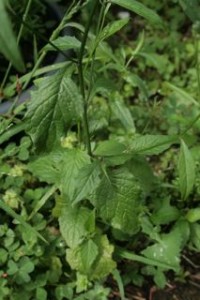
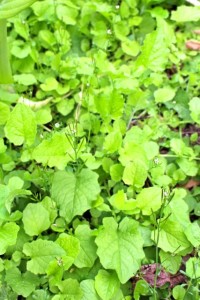
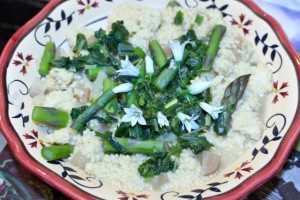
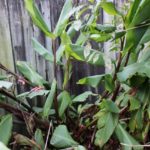

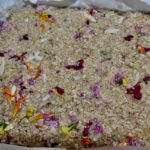
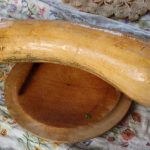
Hi Julia, I am back on air again after our move from warm Northland to the Hawkes Bay. Moving is fun but it sure is disruptive. All my poor living cultures have suffered of neglect and I can feel for the plants when we transplant them. However I have a whole new field of weeds to explore and I cannot wait till you are coming down here to do your workshop on the 29th of this month with Setha and show me what ‘weed eating’ can happen here. It is funny but on my own I am still challenged to find the weeds you mention in your blog posts. I have been on the look-out for nipplewort ( I agree about the name) and have not seen any. I cannot wait till you are here to open my eyes. Once you have shown it to me, I will of course see it everywhere but until then it sure is alluding me. I have found cleavers though and finding weeds still feels like an easter egg hunt to me. Haven’t found chickweed yet though and millet is also not in my cupboard so I have to be patient until I have all the ingredients to make this dish. It sounds like fun and again something different to add to the repertoire which is always so welcome. AND…see you soon in the Hawkes Bay.
HI Wilma, that is really cool that you’ve found some weed friends in your new sunny location!! I believe you when you say moving is disruptive but you’re so good at caring for the plants that I believe they will be very forgiving and settle in soon.
I was like that with nipplewort – hadn’t even seen it and now see it everywhere and I wonder if it happens to be more prolific this year, but I suspect it is just that I never ‘saw’ it. I am very much looking forward to seeing your new field of weeds and discovering what is there. And I’m looking forward to the the workshop at The Farmhouse Kitchen on Sunday 29th Nov with you and John assisting Setha with her seed workshop and I with my weed workshop and in between enjoying Pauline’s lunch. Instead of millet for the nipplewort recipe you could use rice. I had millet that is why I used it, but the Japanese would use rice in their spring soup. See you soon…..
Yes, rice is a good idea because I have never had millet in my cupboard…..yet.
Hi I thought I may just add some stuff about millet, in some cultures millet is considered the king of grains…. It’s been a prized crop in China, India,Greece, Egypt and Africa. Gluten free, it’s often called a grain because of it’s grain like consistency, but millet is actually a seed. Full of magnesium, calcium, manganese, phosphorus, tryptophan, and B vitamins. According to the body ecology website , It can act as a prebiotic to feed the microflora in your gut, provide serotonin to calm and soothe your moods. It can help hydrate your colon and keep you regular. Its easy to digest and alkalising. It’s got a great nutty flavour and is greatly enhanced by adding onions and salt when you are cooking it.
Adriana, that is most interesting information about millet. Like Wilma I don’t have millet in my cupboard, but this year discovered i had a genetic vulnerability to gluten…can eat it but have to limit amounts so millet adds another option to my repertoire Thanks!
Marilyn of westmere
HI Adriana,
thank you for this information about millet. It is very nutritious and no wonder it has been a prized crop in so many countries. Thanks for taking to time to post your comments. Much appreciated!!
I have picked the nipplewort out of my garden and microwaved it in a pyrex dish. I then put it through the Magic Blender as it is quite fibrous and having it with my bacon and eggs and in quiche types foods and it seems to be really good. It tastes like a cross between silver beet and lettuce.
Hi Carlinda,
thank you for writing and sharing your experiment with nipplewort – fantastic – the dish sounds delicious!! I will try it myself.
So glad you felt confident to use it that way. Wonderful!!
Just found this post on weeds and am loving it. Nipple wart grows EVERYWHERE here in western Washington and am going to enjoy the micro green next year as its all gone to flower this year. We have abundant weeds here that are mentioned on your post. I’ve got one that may be millet but am not convinced that what I am seeing is the grain. Purslane grows abundant here as does broad leaf plantain and herb Robert witch was facanating to read about. Thank you so much for your site and the great info. Eric
Hey Eric I am also in Western Washington (Ferndale) I will be munching down with you LOL, hey it’s Almost the end of October and it’s still growing in my back yard. The smaller plants seem to take on a different look or vise versa they might be
the best?
Shawn
HI Eric, so great to hear from you all the way over in Western Washington. Isn’t it amazing how these plants we call ‘weeds’ are found in many countries around the planet. They are global beings like us really and adaptable like us. I’m so glad you enjoyed the post and like the website. I also appreciate you writing in and giving this feedback. I’m sure the weeds are so delighted you’re taking notice of them and giving them energy. Have a great summer. Here it is mid winter and very, very wet.